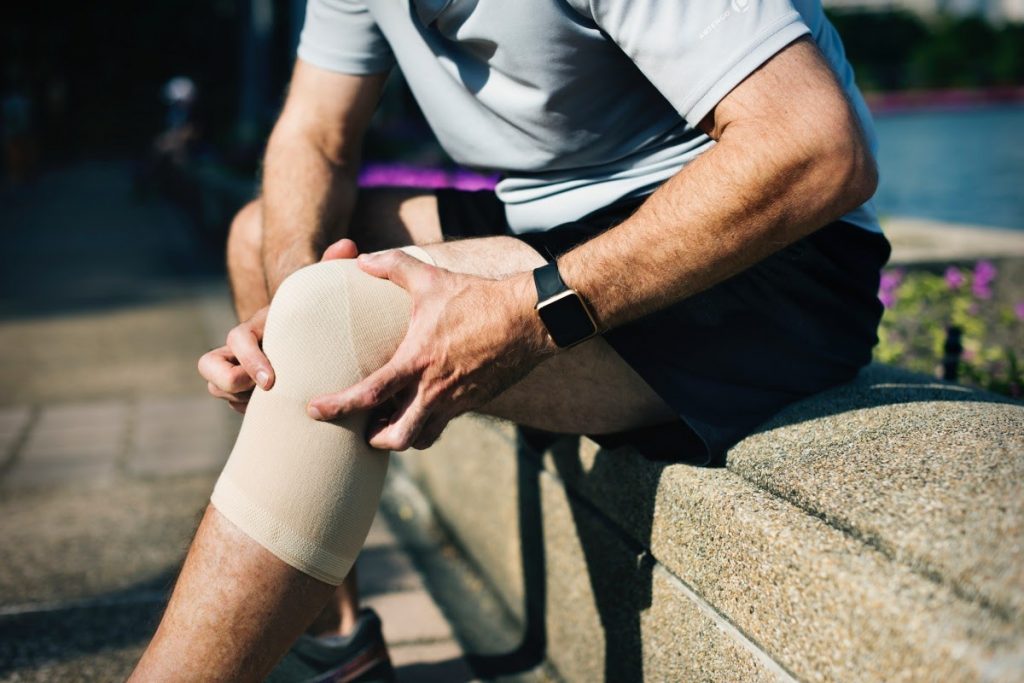Hyperextended Knee- Symptoms, Treatment & Exercise

We all have heard horror stories of sports-related injuries. Knee injuries are one of the most difficult to deal with; mentally and physically. For an athlete, a knee injury, especially the ones involving injuries to their ACL, or anterior cruciate ligament can mean a long time out on the sidelines or also an end to their career (in some critical cases). Ask any athlete and they will tell you how arduous the recovery process is.
If you have suffered a knee injury recently and are reading this post to get some help, I would like to tell you that you are on the right path. With a knee injury, it is crucial to diagnose it first and also get the correct treatment as early as possible. In case you injured your knee while running or landing from a high jump, you should consider the possibilities of it being a hyperextended knee.
In this post, I am going to be discussing hyperextended knee, it’s symptoms, treatment, and exercises.
Before we move ahead, it is crucial to consider the following conditions that can cause you to exert similar symptoms as that of the hyperextended knee.
1) Irritation while bending or moving the knee joint. This might be a result of an inner meniscus tear or a cartilage injury.
2) Extreme pain and complete immobility. Such symptoms commonly occur as a result of (anterior cruciate ligament) ACL tear.
3) The muscles and blood vessels around your knee couple be sore as a result of performing activities like cycling or walking.
4) Your knee could be aching, swollen, and stiff due to a condition called Knee arthritis. Knee arthritis can cause inflammation of one or more of your joints.
5) Is the pain in the rear part of your knee? You could be suffering from Baker’s cyst–a fluid-filled cyst is formed behind the knee.
The Most Common Symptoms of Hyperextended Knee
1) Instability of the Knee
Depending on the extent of the injury, a hyperextended knee can make it difficult to stand straight or walk without a limp. Instability in the knee is observed more commonly immediately after the injury. In sports, the athlete walks gingerly after the impact and is more often subbed off or is forced to forfeit the game.
2) Intense Pain

Again, the degree of pain depends on the extent of the injury. If the athlete suffers tears in one or more of the ligaments, he/she is going to feel intense pain in the back and/or front part of the knee. There is no way to predict how and at what angle the knee could get hyperextended. Hence, the degree of pain varies from person to person.
3) Immobility
Along with immobility, a hyperextended knee can also make it difficult for you to walk at all. In some cases, the injured person can walk with crutches, while in other cases, physiotherapists ask the patient to avoid putting any pressure on the knee– more damage to the knee joint can aggravate the condition.
4) Visible Bruising
In some cases, the surrounding blood vessels, connective tissue, and nerves are also damaged sure to hyperextension of the knee. If the knee is not treated immediately (with RICE treatment; which we will discuss later in the post), the skin surrounding the knee begins to darken. The visible bruising makes the injury look even worse than it is.
The Best Treatment Options for Hyperextended Knee
RICE is an acronym for a treatment method for soft tissue injuries developed by a sports medicine doctor Gabe Mirkin, M.D. in the year 1978. It stands for Rest, Ice, Compression, and Elevation. Dr. Mirkin has been practicing medicine for more than 50 years.
He is also quite popular among the marathon runner’s community for his radio talk show–The Dr. Gabe Mirkin Show. I am recommending this technique for anyone who wants quick relief from excruciating pain caused by a hyperextended knee.
1) R- Rest
Rest is one of the most important elements when you are trying to heal your hyperextended knee with the RICE technique. After the occurrence of this injury, it is recommended not to walk home without the support of a friend or a teammate. If possible ask someone to drive you home. Once you reach home, make sure you are well-rested and comfortable.
2) I- Ice
The next thing you can do to speed up the recovery process is massaging the affected area topically with some ice cubes. There are several effective ways to massage but Dr. Mirkin recommends a method that involves “alternation of ice and no-ice for 15–20 minutes each, for 48 hours.” Doing this will reduce the inflammation and pain in the affected area.
3) C- Compression
Compression seizes the formation of fluid within the knee joint region. This condition is also known as “water on the knee” among athletes. This happens as a result of inflammation in the joints, muscles and soft tissue. Dr. Mirkin recommends covering up the affected area with an elastic bandage. A right amount of compression is needed to lessen swelling and abrasion.
4) E-Elevation
Finally, when you are done relaxing, icing and pressing the affected area, make sure you rest with your feet elevated above your heart. Raising your injured leg will allow blood to circulate properly. Place your injured leg on a pile of pillows while sleeping. Make sure the angle of elevation is approximately 30-40 degrees.
The Best Exercises for Hyperextended Knee
1) Straight-leg raises: To perform this exercise, you can either lie down on your back or stay seated with your legs straightened. Lift your injured leg, hold it for 5 seconds and then bring it down. Perform 3-5 sets with 0-15 reps in each set.
2) Wall sits: Place your head, back and buttocks on a wall. Lower your entire upper body with feet shoulder-width apart and your knees bend at a 45-degree angle. Perform 10 sets each day with 1 rep in each set.
3) Hamstring stretch: Along with your knee joints, it is essential to stretch and strengthen your hamstring muscles. Hamstrings are located at the back of your thigh. To perform an easy hamstring stretch, bend your non-operative knee, place your injured leg forward, lift your upper body and push your buttocks out. Hold the stretch for 5 seconds and get back to your original position. Perform 5 sets with 8-10 reps in each set.
Conclusion
A hyperextended knee can take anywhere between 2-8 weeks for recovery– depending on the extent of the injury. Throughout the recovery period, it is recommended to nurse the injury with the RICE technique and also perform the exercises mentioned in this post. If the condition does not seem to improve within a week (or the pain gets worse), immediately consult a physiotherapist.
